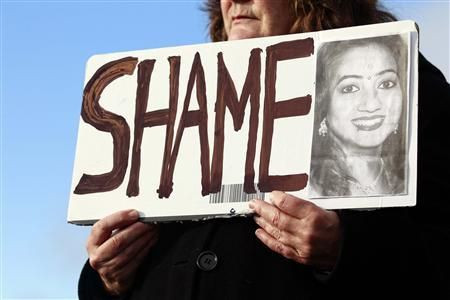Savita Halappanavar: The Latest Chapter In Irish-Indian Relations

Ireland and India have scarce little in common, save for a shared history of British imperialism.
However, now well into the 21st century, an Indian immigrant woman in Ireland has emerged as the martyr of a social movement that could ultimately lead to a dramatic shift in Irish society and government policy.
Late last month, Savita Halappanavar, a 31-year-old female dentist, died of blood poisoning in a hospital in Galway, Ireland, after medical staff refused her request for an abortion in the 17th week of her pregnancy, complaining of severe back pains. Among other things, nurses and hospital staff stated that in a “Catholic country,” a hospital in Ireland could not abide by her pleas.
Savita’s untimely death has sparked outrage from Dublin all the way to India, leading Irish pro-choice activists to protest and demand that the Dail (the Irish parliament) reform the nation’s abortion laws.
Ireland is one of the last remaining European Union states where abortion is essentially illegal. While the law stipulates that pregnancy may be terminated if the mother’s life is deemed at risk, even in this scenario the procedure is rarely carried out.
The confusing laws have traditionally forced untold thousands of Irish girls and women -- often at great cost and risk -- to seek out abortions in Britain or even continental Europe over the decades.
Now, Savita’s tragic death may serve as a catalyst for the Dublin government to either clarify the abortion law or revamp it entirely.
“The anger extends beyond Ireland,” pro-choice campaigner Sinead Kennedy of the Irish Choice Network declared at one of many protest demonstrations across Ireland over the weekend, according to the Irish Times newspaper.
“We have seen political cowardice and inaction on this [abortion] issue. The theme of this march is ‘Never Again.’ Never again will a woman be allowed to die.”
Another activist, Sinead Ahern of Choice Ireland, told an assembled crowd that a global movement was coalescing around Savita.
“As huge as the crowd is today, we are only part of what is happening. ... Today we march, and today we stand in solidarity,” she said.
"Tonight is about solidarity. Tonight is about showing Savita's family that we are sorry for what has happened to her and we are sorry for the terrible tragedy that has happened. Today marks the day that there is no more stigma [in having an abortion] and no more shame."
As former possessions of the once-vast British Empire, Ireland and India -- despite their multitude of differences -- have been linked historically for centuries and cooperated in other movements, most notably the fight for independence from Britain.
Indeed, the flags of India and Ireland look remarkably similar bearing the same basic design and colors: orange/saffron, white and green. For the Indian flag, saffron refers to Hinduism, green to Islam and white for peace. Similarly, the saffron (or orange) in the Irish flag refers to Protestantism, green for Irish Catholics and, again, white for peace between the two communities.
Beyond the symbolism and colors, Ireland and India (8,000 miles apart) enjoyed a deeper relevance -- the Indian constitution featured elements adopted from its Irish counterpart.
Since the independence of India in 1947, the leaders of the two countries have made a number of state visits over the years. Not only politicians like Jawalharlal Nehru and Éamon de Valera, but also brilliant authors like Rabindranath Tagore, W. B. Yeats and James Joyce exchanged epic journeys between the two distant lands.
Thousands of Irish civil servants, missionaries, scientists, doctors, nurses and military officials served in India under the auspices of the British Empire.
But perhaps the most powerful figure in Irish-Indian solidarity came in the form of Annie Besant, the British-born Irish socialist and activist who supported "home rule" (independence) for both India and Ireland. She spent much of her adult life in India and deeply involved herself in Indian independence and the nationalist Congress party.
In 1985, a tragedy again united India and Ireland.
That summer, an Air India carrier, flight 182, was blown up off the coast of Ireland by Sikh separatists, killing more than 300 people. Irish state personnel quickly sprung to action in rescue and salvage efforts.
“Ireland, with its minuscule population lying at the very western edge of Europe, had and still continues to have a notable influence on the history and politics of the vast Indian subcontinent,” Irish blogger Brendan Smith commented.
India and Ireland today enjoy friendly diplomatic relations and strong trade and cultural ties.
About 25,000 Indians now reside in Ireland -- one of them was Savita Halappanavar.
© Copyright IBTimes 2024. All rights reserved.



















